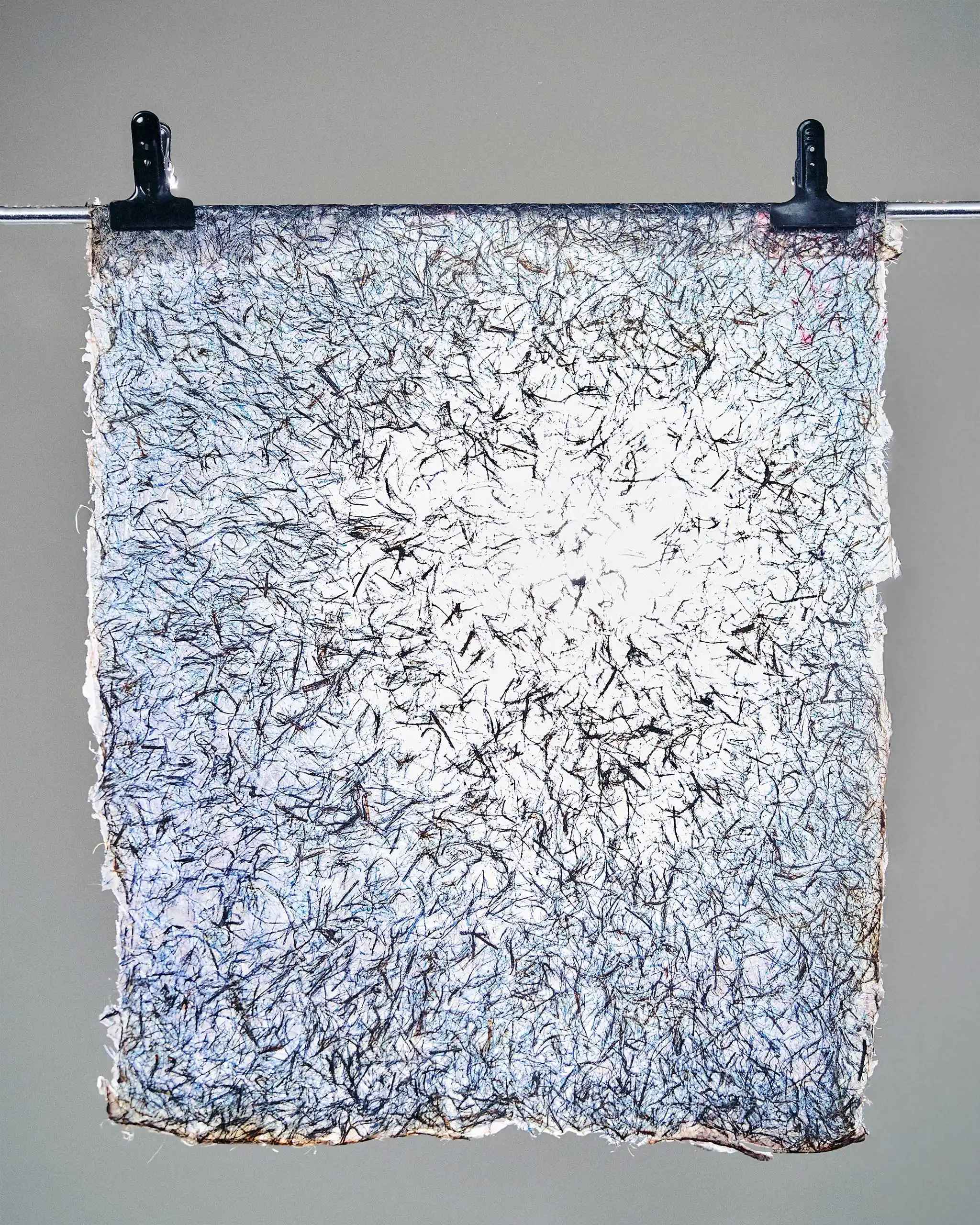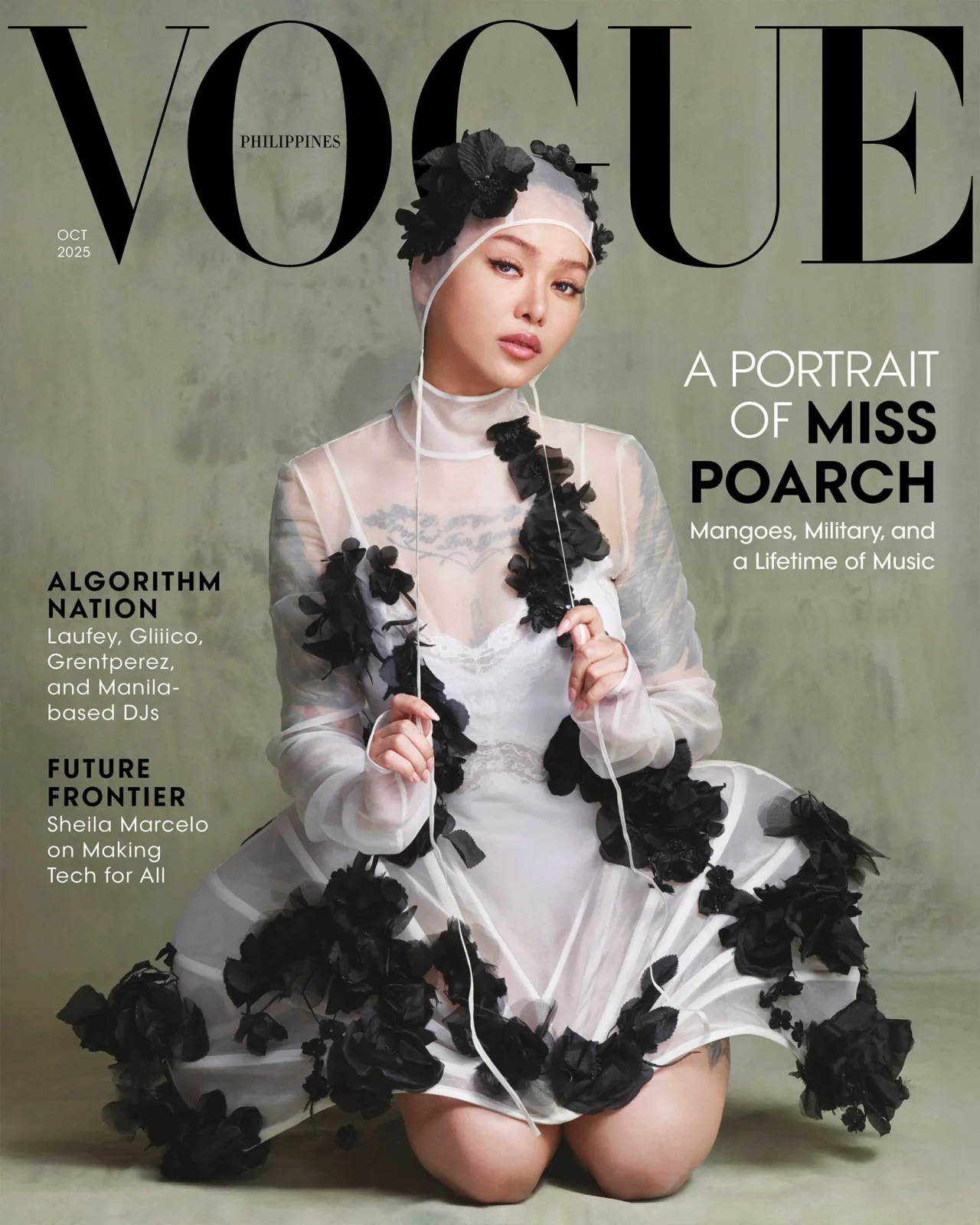Photographed by Karl King Aguña for the October 2025 Issue of Vogue Philippines
For the founders of Konstratá Leather, banana and algae mark new beginnings for bio-based textiles in the Philippines.
It looks like a living thing. From a different planet. Or something preserved in a lab, like if a mysterious, monstrous glob suddenly fell on earth and had to be pressed into a thin sheet to be contained.
The translucent, jelly-like texture is flecked with short strands all over, and truthfully, it’s a curious piece of material to behold. Speaking to the hands and minds behind this bio-based leather, however, it seems that this is the point.
“We have our tagline, ‘Fibers don’t hide.’ We want the fibers to be the champions. We want it to be the main star of all our products,” asserts Tal de Guzman. “And so it was something that we really tried to share with people, that we won’t be looking like your typical animal leather, or your typical plant-based leather that you can find right now in the market. We want it to be something different. We want you to feel the texture. We want you to feel the fibers.”
Tal is one of three founders of Konstratá Leather, a start-up for developing and manufacturing leather from banana and algae. She is joined by her former student and technical fashion designer Micca Amor, and young entrepreneur Vinz Mamalateo. Their name, which is an amalgam of the Spanish word “con” or “with” and “strata” meaning “layers,” speaks for their larger mission to create consciously with every step.
As a team, they’re aware that alternatives to animal leather aren’t new. In fact, they cite Stella McCartney, the English designer and self-proclaimed “eco-weirdo” who is best known for shunning animal products in her collections. She has advocated for responsible materials since the launch of her namesake label in 2001, championing everything from Kelsun or seaweed-based yarn from Keel Labs, to Vegea’s leather made from grape waste.
Then there’s also Piñatex or pineapple-based leather developed by Dr. Carmen Hijosa, originally from Spain. Backed by design and manufacturing expertise in leather goods, she came to the Philippines in the 1990s as a consultant for Design Center of the Philippines, and ended up extensively researching pineapple fibers.
Tal herself worked with the government to create finished products from bio-based leather alternatives they were developing, but the partnership came to a standstill. A shoe designer of over a decade, Tal is also a faculty member at the De La Salle-College of Saint Benilde’s fashion design and merchandising program, where Micca was enrolled. “With fashion design, there’s different areas,” the latter explains. “Some people are good with design, some people are good with construction, or fabric manipulation, and I was trying to discover that throughout my college years. And then I realized that I enjoyed my textile classes a lot. It was Miss Tal who was mostly my professor at that time.”
When it came to her thesis project, Tal was Micca’s assigned advisor. She was intent on making her own leather, and at first tried it with kombucha, then orange peels, to no avail. Eventually, she put together wool fiber used for felting and an algae-based mixture, and somehow, it worked. After dyeing it indigo, the final product felt hefty and looked akin to denim.
Although she wished to keep exploring it after graduation, she found that she didn’t have the network or resources to continue. So, the project remained shelved for a time.
Elsewhere, Vinz Mamalateo, an entrepreneurship graduate of De La Salle University, was laying the foundations for his own banana leather company called Philip-Anaban. He’d always wanted to be a social entrepreneur, and it just so happened that after graduation, he came across a TikTok of two Mexican business partners discussing their newly-made cactus leather. “That’s when I got really curious, because you never hear that in the Philippines, right? Usually when you hear about leather, you think about Marikina-made leather and about animal leather,” he narrates. “But after doing some research, you realize that in terms of the creation of animal leather around the world, how destructive it can get, how unsustainable it can get, and at the same time, the potential of bio-based leather for our world and for the industry as well.”
A consultation with Tal revealed a shared connection with Villa Socorro Farm, a social enterprise based in Pagsanjan, Laguna, who supplied Vinz with banana trunk waste for his initial sampling and whose owner, Raymund Aaron, Tal has known for over a decade. He pursued it for Philip-Anaban, only for it to become too time-consuming and financially heavy. Like Micca, he parked the idea for the meantime.
Serendipitously, Vinz bumped into Tal at an event, where they got to catching up on their respective undertakings. Seeing the potential of collaboration, Tal got in touch with Micca to propose a Zoom meeting where all three of them could discuss. Such were the seeds they sowed to form Konstratá, an endeavor that brings together Micca’s algae experiments, Vinz’s banana fiber research, and Tal’s industry experience.
Since forming in December of 2024, they’ve gone through countless trials and errors, prototyping swatches of varying thickness, color, and composition and fashioning them into small and medium goods like keychains, pouches, and sandals. Given their capacity and manpower (both women have full-time jobs, while Vinz moved to Canada earlier this year to take up further studies), they haven’t been able to devote as much time to R&D as they would like.
The act of crafting the leather itself is lengthy and laborious; Tal reveals that preparation of the fibers isn’t just the first step, but also
one of the longest. “The fibers come to us pretty raw. We have to separate them, make them small enough to be processed. And then alongside that, Micca, who’s more [of an] expert on the alginate, [is] the one preparing the solution whenever we do the samples,” she details.
They first attempted to use banana peels, but found that apart from decom- posing quickly (and therefore contribut- ing to contaminants in the production), it ultimately went against their sustainabili- ty goals as peels take longer to clean, and use more water while yielding very little fibers. Now, they derive material solely from tree trunks because of its strength and accessibility; banana trees are usually cut down and disposed of post-harvest, as each one bears fruit only once.
As soon as the fibers are prepared, they are laid out on a flat sheet mold with the alginate then left to air dry. They didn’t mind the wait time until the wet season came. The constant downpours meant little to no sunlight, which in turn meant prolonged periods of drying.
Thankfully, through a crowdfunding campaign with The Spark Project, they raised enough funds to purchase a medi- um-sized dehydrator which has signifi- cantly reduced drying from one to two weeks to two to three days. They’ve also recently incorporated an anti-mold solu- tion to their formula, which prevents the fabric’s degradation and keeps its aroma fresh. Upon receiving their latest batch of swatches, Tal shares her surprise at her husband complimenting the scent un- prompted, and her colleague telling her it smells like cereal.
The trio makes it clear that banana is simply the starting point for Konstratá, and they’re eager to explore further ap- plications of different plants from abaca to orange to pineapple. Through their on- going research, Vinz says that they “get to not only discover which ones work best for us, but at the same time, we get to discov- er new combinations that will hopefully spark research within the Philippines and internationally as well. You’d be surprised; globally, you’d see probably about 10 real- ly, really well known plant-based or bio- based leather companies, but most of them would be using a type of plastic material.”
Tal expounds that these eco-con- scious fabrics aren’t always a hundred percent sustainable due to the finishing or top layer, often made with polyurethane which is partially plastic. “But for us, we do use the alginate material, that binding material that Micca was able to use for her thesis,” Vinz points out. “We are the third largest banana exporter and producer in the world, and so that does help out when your country exhibits a lot of these mate- rials. We also have access to this with one of our very good partners, Villa Socorro Farm. So not only are we helping out the banana farmers immediately, we’re also helping out a local and social enterprise.”
For all their recent developments, however, they are forthright about multi- ple roadblocks they currently face, such as Vinz being all the way in Canada while Tal and Micca remain based in the Philippines. The former is apologetic about not being on-ground for manufacturing and oper- ations, but Tal is quick to interrupt him to say, “Vinz is downplaying his contribution!” From Vancouver, Vinz heads research, ap- plies for grants, and takes care of their in- boxes; meanwhile, Tal and Micca inundate their group chat with images and messages of their progress, no matter how big or small.
The interest in their venture is far-reaching, and Vinz happily shares that they’ve gotten inquiries from beyond the archipelago. “Somebody from the Nether- lands saw our news feature and she reached out asking if she could meet up with us, trying to see where we’re at as a team. We’ve had students ask us if we could help out with their thesis, with their research on bio-based materials and manufacturing. We’re very happy to be a part of, hopefully, what will be a movement for sustainable bio-based leather manufacturing here in the Philippines. We may only be a team of three, but hopefully we’d be able to make a bigger impact than we set out to have.”
For Tal and Micca, the most reward- ing moments are when they actually get to peel the leather from the sheet molds; when they’re able to produce new results and come to new realizations together. “We do want the partners, we want the partnerships, but also the right kinds of partnerships that are aligned with the values that we have in terms of sustain- ability, in terms of impact,” Tal ada- mantly says. “Because I think that will make all the difference. Whether, as we grow, stay true to our values or not. That’s very crucial.”

